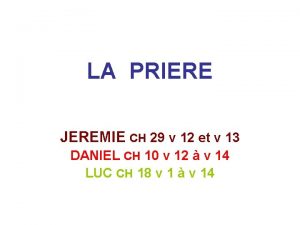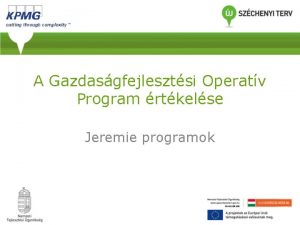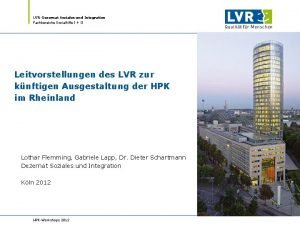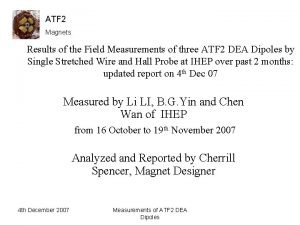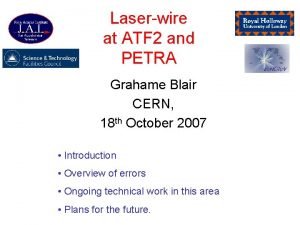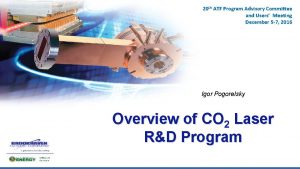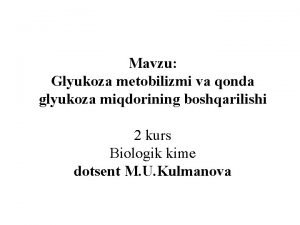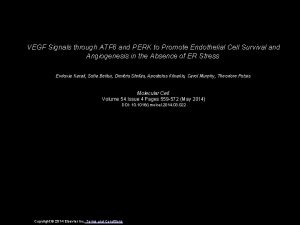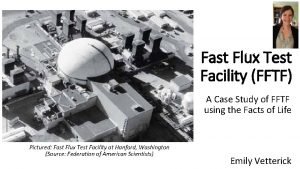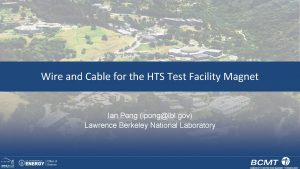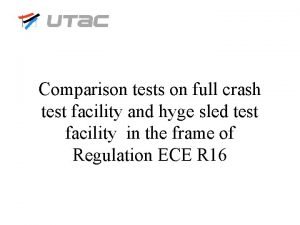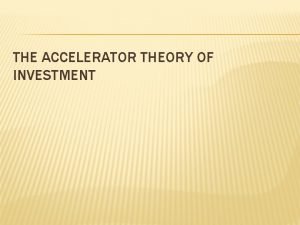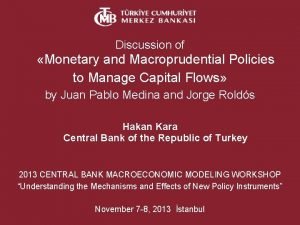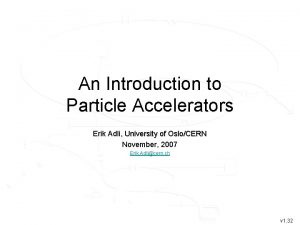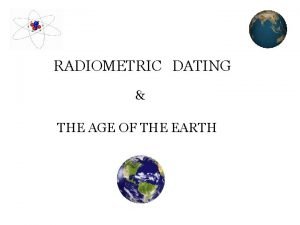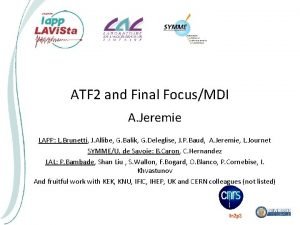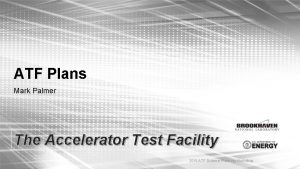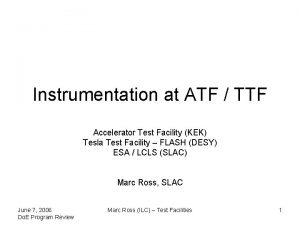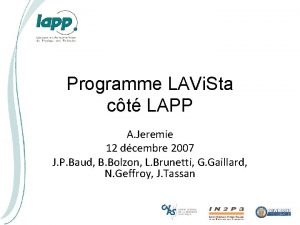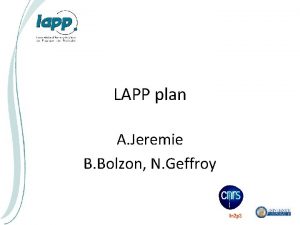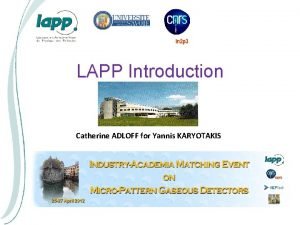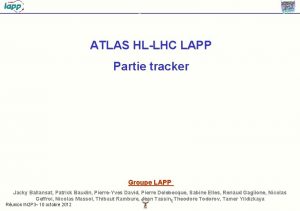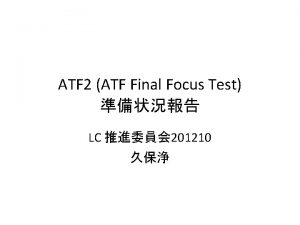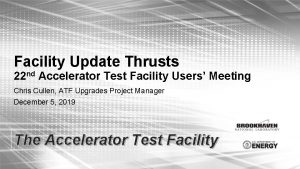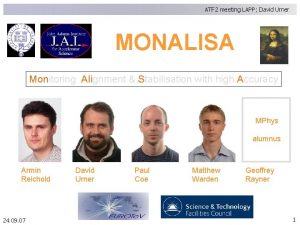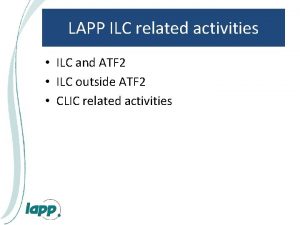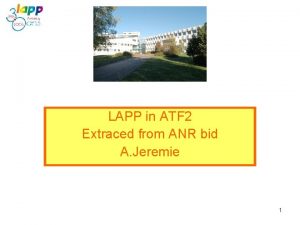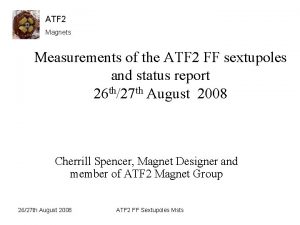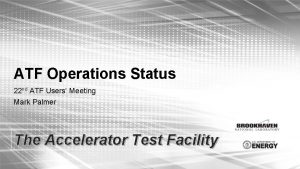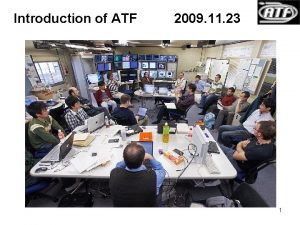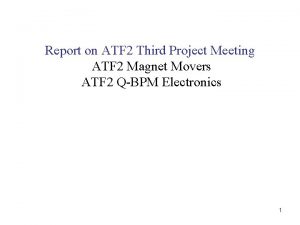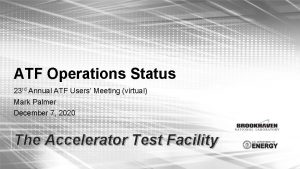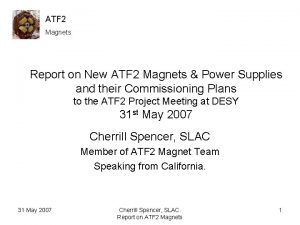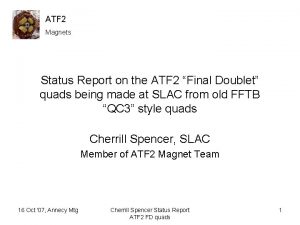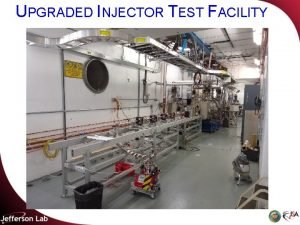ATF 2 Accelerator Test facility A Jeremie LAPP





























- Slides: 29

ATF 2: Accelerator Test facility A. Jeremie LAPP: A. Jeremie LAL: P. Bambade, Shan Liu , S. Wallon, F. Bogard, O. Blanco, P. Cornebise, I. Khvastunov, V. Kubytskyi And fruitful work with KEK, KNU, IFIC, IHEP, UK and CERN colleagues (not listed)

What was done by the French teams around ATF 2 • • • Introduction Vibrations and GM feedforward IP-BPM and chamber Beam-halo evaluation : diamond sensor Conclusion Outlook 3 e JCL à Grenoble 1 -3 décembre 2014 2

• Goal 1: 37 nm beam at the focal point in a stable and reproducible manner • Goal 2: Stable trajectory (D<2 nm) and ILC-like intratrain feedback Shintake monitor 3 e JCL à Grenoble 1 -3 décembre 2014 3

“Routinely” produce 45 nm beams at ATF 2! Shintake Monitor: essential for beam tuning Focused beam Less focused Modulation of photon rate by Compton diffusion on interference fringes 44 nm beam size: Already a record! 4 Big step towards ILC feasibility! 3 e JCL à Grenoble 1 -3 décembre 2014

What was done by the French teams around ATF 2 • • • Introduction Vibrations and GM feedforward IP-BPM and chamber Beam-halo evaluation : diamond sensor Conclusion Outlook 3 e JCL à Grenoble 1 -3 décembre 2014 5

14 Guralp 6 T sensors all along ATF 2 Guralp 6 T: 0, 5 Hz-100 Hz, two directions connected (vertical and horizontal can be placed parallel or perpendicular to beam direction), mainly in Extraction line, 2 sensors easily relocated 3 e JCL à Grenoble 1 -3 décembre 2014 6

What magnets need studying? QF 1 FF IP QD 10 FF pair QD 0 FF Tolerance (vertical) QD 0 FF QF 1 FF (old support and magnet) QF 1 FF (new magnet and support) 7 nm (QD 0) 20 nm (QF 1) 4. 8 nm 6. 3 nm 30 nm The most sensitive magnet is QD 0 FF, then comes QF 1 FF (which was recently changed and needs to be studied) then QD 10 FF pair 3 e JCL à Grenoble 1 -3 décembre 2014 7

Relative displacement at 1 Hz QD 10 FF/floor Vertical Horizontal (nm) No cooling No shims 7, 3 98 Cooling No shims 18 150 Cooling Shims 15 100 QF 1 FF/tabletop Vertical Horizontal (nm) No cooling No shims 20 150 No cooling Shims 15 95 Cooling Shims 16 120 3 e JCL à Grenoble 1 -3 décembre 2014 • Shims help but not significantly • Cooling has dramatic effect • More stable support gives better vibration behaviour • Support can benefit from upgrade study 8

Another vibration source identified Sensor 1 still noisy, but vibration improvement After pipe repositioning Sensor 2 This pipe has been placed so as to avoid touching girder Unfortunately these cannot be changed easily in a quick fix Step after step: vibration source identification 3 e JCL à Grenoble 1 -3 décembre 2014 9

ATF 2 GM feedforward test • Goal – Predict Ground Motion (GM) effect on beam trajectory with GM sensors – Compare with BPM reading • Motivation – Probably the first time GM sensors are compared to BPMs – Demonstrate feasibility of a feedforward based on GM sensors – Feedforward would allow trajectory correction based on GM sensors (get independant information between pulses) – Possible big savings by relaxing mechanical quadrupole stabilisation specifications at CLIC – Global scheme instead of local mechanical correction IRFU LC-days November 27 -29 2013 10

First results • GM effect small compared to orbit jitter: difficult experiment at ATF 2 • Incoming jitter can be measured by BPMs and removed from downstream BPM measurements • Low resolution BPMs at beginning • One can expect the GM effect can be detected by BPMs after jitter removal. • Typical “best” BPM ( ) in vertical direction • BPM measurement with jitter removal vs BPM position predicted from GM sensor measurement: nice correlation! • Still need to evaluate if by removing strong vibration sources, this correlation remains GM sensors powerful detecting vibration sources Novel GM mitigation technique: promising! 3 e JCL à Grenoble 1 -3 décembre 2014 11

What was done by the French teams around ATF 2 • • • Introduction Vibrations and GM feedforward IP-BPM and chamber Beam-halo evaluation : diamond sensor Conclusion Outlook 3 e JCL à Grenoble 1 -3 décembre 2014 12

New IP-BPMs and chamber In addition to the Beam Size monitor (Shintake Monitor), we also have Beam Position Monitors (BPM) around IP B A C A precise mover system (piezo movers PI and Cedrat) has been designed precise remote mechanical alignment of IP-BPMs (since in vacuum chamber) mechanical calibrations of IP-BPM scale factors with required precision (instead of moving the beam as before); their calibration, reproducibility and linearity below 10 -4 3 e JCL à Grenoble 1 -3 décembre 2014 13

BPMs displacement system (inside chamber) One piezo-actuators/block for BPM lateral displacement ~300 um 3 piezo-actuators/block for BPM vertical displacement ~300 um res» 26 nm IP Measured versus predicted bunch position 14

3 e JCL à Grenoble 1 -3 décembre 2014 15

IPBPM alignments after recent reinstallation 200 um vertical misalignment correction 0. 75 mrad pitch angle correction AB C Beam direction After the vertical misalignment correction about 200 um. IPB-YI’ IPA-YI’ IPC-YI’ 13. 75 um 200 um IP Beam direction 230 um IP 167 um 18. 75 um 39 um Beam direction We re-calculated the vertical misalignment IPA-YI’ after 1. 5 mrad pitch angle correction with 900 um shift up! The average misalignment was 200 um. 3 e JCL à Grenoble 1 -3 décembre 2014 IPC-YI’ 16

IP-BPM calibration • IP-BPM misalignment corrected so that beam passes through all 3 BPMs • IP-BPM calibration done => New IP-BPMs and improved IPchamber operational! 3 e JCL à Grenoble 1 -3 décembre 2014 17

What was done by the French teams around ATF 2 • • • Introduction Vibrations and GM feedforward IP-BPM and chamber Beam-halo evaluation : diamond sensor Conclusion Outlook 3 e JCL à Grenoble 1 -3 décembre 2014 18

Accelerator Test Facility (ATF) @ KEK S. LIU, P. BAMBADE et al. , LAL-CNRS/IN 2 P 3 low energy (1. 3 Ge. V) prototype of the final focus system for ILC and CLIC Goals of ATF 2 Ø goal 1—achieving the 37 nm design vertical beam size at the IP; Ø goal 2—stabilizing the beam at that point at the nanometer level; Diamond Sensor Interaction Point Beam Size Monitor (IPBSM) Beam Halo -> major background for IPBSM !!! Compton Beam Halo Compton δp/p 0=0. 0008 DS scan In Vacuum Diamond Sensor (DS) Ø Scan beam halo transverse distribution → investigate & control ATF 2 beam halo Ø Probe Compton recoil electron→ investigate the higher order contributions to the Compton process

Installed at ATF 2 in Nov. 2014 The first Diamond Sensor is installed horizontally at ATF 2. The main purpose is to measure the beam halo distribution. @CIVIDEC Initial Waveform Beam Core Scan Preliminary Total Beam intensity: 1. 2*109 Voltage on DS: -40 V Beam Halo Scan Preliminary Total Beam intensity: 5. 2*109 20 Voltage on DS: -400 V

Installed at ATF 2 in Nov. 2014 The first Diamond Sensor is installed horizontally at ATF 2. The main purpose is to measure the beam halo distribution. @CIVIDEC Initial Waveform Beam Core Scan Beam Halo Scan Diamond Sensor operational and taking data in horizontal scan! Preliminary Total Beam intensity: 1. 2*109 Voltage on DS: -40 V Preliminary Total Beam intensity: 5. 2*109 21 Voltage on DS: -400 V

What was done by the French teams around ATF 2 • • • Introduction Vibrations and GM feedforward IP-BPM and chamber Beam-halo evaluation : diamond sensor Conclusion Outlook 3 e JCL à Grenoble 1 -3 décembre 2014 22

French teams involved in ATF 2 have signed E-JADE 3 e JCL à Grenoble 1 -3 décembre 2014 23

Conclusion Outlook • Contribute significantly to ATF 2 Goal 2 – GM measurements and mitigation, aim at GM feedforward test , Halo measurements, Contribute to ATF 2 beam size reduction and stabilisation with IP-BPMs • Contribute to ILC and CLIC • Successful in several Collaborations and great opportunity with EJADE further harvest fruitful exchange with KEK experts • Publications and conferences • Training of students on a working accelerator (preparing future) • Getting precious experience to contribute to future machines and experiments! 3 e JCL à Grenoble 1 -3 décembre 2014 24

extras 3 e JCL à Grenoble 1 -3 décembre 2014 25

3 e JCL à Grenoble 1 -3 décembre 2014 26

Diamond Detector Features Property ADVANTAGES Diamond Silicon Density (g m-3) Band gap (e. V) Resistivity (Ω cm) Breakdown voltage (V cm -1) Electron mobility (cm 2 V-1 s-1) Hole mobility (cm 2 V-1 s-1) Saturation velocity (μm ns-1) Dielectric constant Neutron transmutation cross-section(mb) Energy per e-h pair (e. V) Atomic number Av. min. ionizing signal per 100 μm (e) 3. 5 5. 5 >1012 107 1700 2100 141 (e-) 96 (hole) 5. 6 2. 32 1. 1 105 103 1500 100 3. 2 13 6 3600 80 3. 6 14 8000 • Large band-gap⇒ low leakage current • High breakdown field • High mobility⇒ fast charge collection • Large thermal conductivity • High binding energy⇒ Radiation hardness l Fast pulse ⇒ several ns 11. 7 Test of fast remote readout (fast heliax coax cable + high BW scope) with particles at end of beam line, using existing single crystal 4. 5 x 4. 5 mm CVD diamond pad sensor In-vacuum single crystal CVD diamond sensor profile scanner -> for PHIL and ATF 2 diagnostic (“plug compatible” design) Diamond detector test at PHIL 3 e JCL à Grenoble 1 -3 décembre 2014 27

3 e JCL à Grenoble 1 -3 décembre 2014 28

3 e JCL à Grenoble 1 -3 décembre 2014 29
 Prière de jérémie
Prière de jérémie 30112010 color
30112010 color Jessica jeremie
Jessica jeremie Operatv
Operatv Lapp
Lapp Lucie lapp
Lucie lapp Lapp composite insulator
Lapp composite insulator Gabriele lapp lvr
Gabriele lapp lvr Vincent poireau lapp
Vincent poireau lapp Atf indianapolis
Atf indianapolis Deltb
Deltb Atf application form
Atf application form Atf
Atf Atf
Atf Galaktoza nima
Galaktoza nima Atf hand signals
Atf hand signals Fast flux test facility
Fast flux test facility Cable test facility
Cable test facility Hyge sled
Hyge sled Transformational leadership inventory
Transformational leadership inventory Accelerator theory of investment
Accelerator theory of investment Biztalk accelerator for swift
Biztalk accelerator for swift Netbackup track log location
Netbackup track log location Accelerator effect economics
Accelerator effect economics Accelerator coherency port
Accelerator coherency port Financial accelerator
Financial accelerator Offshore wind accelerator
Offshore wind accelerator Particle accelerator formula
Particle accelerator formula Vm backup best practices
Vm backup best practices Accelerator mass spectrometry
Accelerator mass spectrometry
